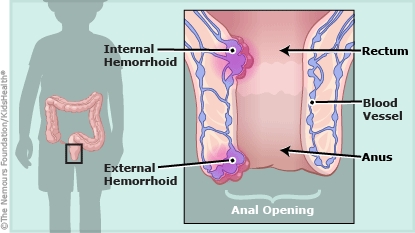Hemorrhoids: How to Care for Your Child
Hemorrhoids can be uncomfortable, but with treatment, symptoms usually go away within a few days. A healthy lifestyle can help prevent them from returning.


Hemorrhoids are swollen veins in the rectum or anus. There are two kinds: external and internal. External hemorrhoids are found around the opening of the anus. Internal hemorrhoids are just inside the anus, in the rectum.
Hemorrhoids may itch or feel painful. Often, kids with hemorrhoids have a small amount of bright red blood on their poop or toilet paper, or in the toilet. Constipation, diarrhea, straining, and sitting on the toilet for long periods are common causes of hemorrhoids.
Most hemorrhoids heal on their own when the cause of the hemorrhoids is treated. The health care provider may recommend ointment, suppositories, or pads to help with pain and itching. The health care provider also may recommend fiber supplements or stool softeners.
Your child can help prevent hemorrhoids from returning by eating a high-fiber diet, getting regular exercise, and practicing good toilet habits.

-
If your health care provider prescribed any medications, creams, or fiber supplements, make sure your child uses them as directed.
-
If your child is uncomfortable, you may give acetaminophen.
-
A sitz bath two or three times a day can help. Have your child sit in warm water up to the hips for about 10 minutes. The water can be plain or you can add plain, unscented Epsom salts to it (1 cup of salts for every 2 quarts of water).
-
Encourage good toilet habits. Your child should:
-
Avoid straining or sitting on the toilet for too long.
-
Go to the bathroom immediately when he or she has the urge to have a bowel movement.
-
Gently use moist wipes or wet unscented toilet paper to wipe after a bowel movement.
-
Ice packs covered in a cloth or cool compresses can help with swelling.
-
Do not give your child laxatives unless the health care provider says it's OK.



A healthy lifestyle reduces the chance of getting hemorrhoids:
-
Encourage your child to get regular exercise.
-
Offer fiber-rich foods, such as fruits, vegetables, whole grains, beans, peas, and nuts.
-
Make sure your child drinks plenty of water.
-
Limit caffeine (found in coffee, tea, sodas, and chocolate).